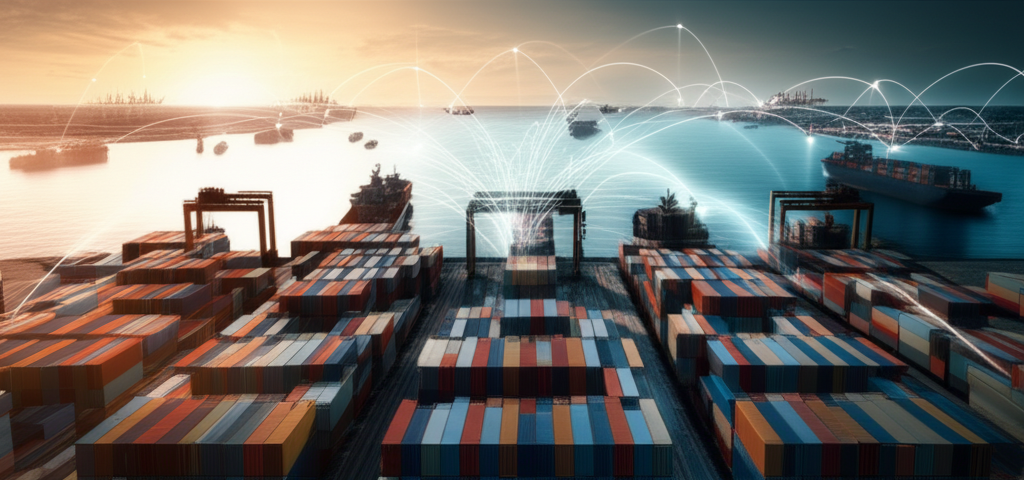From Sea to Shelf: How Geopolitics and Port Congestion Secretly Erode Packaging Costs
Introduction: The Unseen Cost Currents
The Butterfly Effect of Global Supply Chains
A seemingly distant port delay, a regional conflict on the other side of the world—why should these directly impact the costs of your products, from packaging material procurement to final placement on the shelves? This isn't alarmist; it's a reflection of the highly interconnected nature of global supply chains. Today, geopolitical tensions and persistent congestion at global ports are becoming "invisible drivers" of packaging cost optimization, silently eroding profit margins.
This article aims to analyze how these macro-external factors, through complex transmission mechanisms, affect companies' raw material procurement, transportation logistics, and overall supply chain efficiency. More importantly, we will provide a series of countermeasures, especially through the introduction of intelligent technologies and design optimization, to help companies build more resilient supply chains, thereby enhancing their cost management capabilities in an increasingly complex and uncertain global market.
The Vulnerability and Dependence of the Global Packaging Supply Chain
A Highly Globalized Packaging Industry
The modern packaging industry is a typical example of a highly globalized industry, with every link in global packaging production deeply rooted in international cooperation and cross-border trade. From the most basic raw material end, such as wood used in pulp production and plastic particles needed for plastic packaging, to aluminum and steel for metal packaging, their origins are usually distributed all over the world.
Entering the production stage, the manufacturing of packaging equipment, the development of molds, and even specific surface treatments or printing technologies often rely on international technological exchanges and equipment imports. Ultimately, a large number of finished or semi-finished packaging materials need to be allocated and circulated globally through ocean shipping. This path dependence, which is deeply reliant on sea freight, makes the entire packaging supply chain optimization process highly susceptible to external shocks.
Challenges to the "Just-in-Time" Production Model
For a long time, in pursuit of maximum efficiency and minimum inventory, the Just-in-Time (JIT) production model has been widely advocated in manufacturing. This lean management model, under ideal conditions, can significantly reduce inventory costs and operating expenses. However, when the external environment undergoes drastic changes, such as sudden port congestion or geopolitical conflicts, the insufficient risk resistance of the JIT model is exposed. Once key nodes in the supply chain are blocked and raw materials cannot arrive on time, the entire production line may be forced to halt, triggering a series of chain reactions and leading to huge economic losses.
The Direct Shock Waves of Geopolitics and Port Congestion
Port Congestion: A "Time Bomb" of Logistics Blockages
Port congestion has become a normalized challenge for global trade. The causes are complex and varied: repeated epidemics leading to labor shortages, inconsistent national response policies, frequent extreme weather events, and the contradiction between global trade volume growth and the carrying capacity of port infrastructure. These factors work together to make vessel delays the norm, extending waiting times indefinitely, drastically reducing container turnover rates, and leading to a surge in additional costs such as demurrage and detention fees.
For example, in the past few years, major global hub ports, such as the Port of Los Angeles in the United States, the Port of Shanghai in China, and the Port of Rotterdam in Europe, have experienced unprecedented congestion, with hundreds of cargo ships queuing outside the port, seriously disrupting the global logistics rhythm and directly driving up the transportation costs of international packaging services.
Geopolitics: The "Risk Premium" of Uncertainty
The complexity of geopolitics also brings great uncertainty to global supply chains. Conflicts or restrictions on trade routes, such as the disruption of important shipping lanes caused by the Red Sea crisis and the decline in canal capacity, force ships to take longer routes, significantly increasing transportation time and fuel costs. In addition, sanctions and counter-sanctions between countries may lead to restrictions on the import and export of specific national or regional packaging raw materials, key production technologies, or equipment, forcing companies to seek more expensive and less stable alternative solutions.
Political instability will also directly increase transportation insurance costs and supply chain financing costs. This "risk premium" will ultimately be passed on layer by layer, adding to the final cost of packaging products.
Cost Transmission Mechanism: The "Invisible Booster" of Packaging Costs
A Spiraling Increase in Raw Material Prices
The impact of geopolitics and port congestion on packaging cost optimization is first reflected in the spiraling increase in raw material prices. Energy prices, such as crude oil and natural gas, are easily affected by speculation and supply and demand expectations during periods of tense global geopolitical situations, leading to significant fluctuations and directly pushing up the production costs of packaging materials such as plastics, inks, and adhesives.
In addition, port congestion will also affect the global circulation efficiency of bulk basic packaging materials such as wood pulp, aluminum, and steel, leading to supply and demand imbalances and causing price spikes. Exchange rate fluctuations are also a factor that cannot be ignored. Geopolitical conflicts may cause sharp fluctuations in major currency exchange rates, increasing the cost of imported raw materials.
Exponential Growth in Transportation and Logistics Costs
For international packaging services, the most direct impact of port congestion and geopolitics is the exponential growth in transportation and logistics costs. Tight capacity, rising fuel surcharges, and the costs of changing routes to avoid risk areas have kept ocean freight rates high, even soaring several times.
At the same time, port unloading delays will also spread to inland transportation, leading to difficulties in truck scheduling, reduced transportation efficiency, and further pushing up inland freight rates. In extreme cases, to ensure the supply of key materials or products, companies may even be forced to choose expensive and uneconomical emergency air freight solutions, which is undoubtedly adding insult to injury.
Intangible Losses in Inventory and Operational Efficiency
In addition to the visible raw material and transportation costs, geopolitics and port congestion will also lead to significant intangible losses. To cope with the uncertainty of the supply chain, companies often have to increase safety stock and hold more raw materials and semi-finished products. This not only increases warehousing, management, and insurance costs, but also ties up a large amount of working capital.
The inability of raw materials to arrive on time will directly disrupt production plans, leading to production line stagnation and declining capacity utilization. In addition, the supply chain team needs to invest more energy in risk assessment, frequent communication with suppliers, and the development of contingency plans, which generates additional management and labor costs. These seemingly indirect costs are invisible obstacles on the road to packaging cost optimization.
Corporate Response Strategies: From Passive Acceptance to Active Resilience
Faced with increasingly severe external challenges, companies must shift from passive acceptance to proactive management and build more resilient supply chains.
Building Diversified and Regionalized Supply Chain Networks
Diversification and regionalization are core strategies for enhancing supply chain resilience. Companies should review and adjust their supplier structures to avoid over-reliance on a single country or region, using diversified global packaging production layouts to disperse geopolitical risks. Developing near-shoring or regional supply models, shortening transportation distances, and reducing reliance on ocean logistics can effectively reduce the impact of port congestion. At the same time, establishing a moderate strategic reserve mechanism for key packaging materials is also a necessary buffer measure to cope with short-term supply shocks.
Embracing Data and AI Intelligent Tools to Enhance Supply Chain Prediction and Responsiveness
In the digital age, data and AI intelligent tools are key to enhancing supply chain resilience. By introducing supply chain visualization platforms, companies can track cargo status in real time, predict potential delays, and improve decision-making efficiency to optimize packaging supply chain optimization. Using big data and predictive analytics tools, companies can proactively identify risks such as port congestion and route disruptions and achieve preemptive packaging cost optimization.
Furthermore, intelligent supply chain optimization algorithms can optimize transportation routes and inventory management, improve overall operational efficiency, and even give rise to intelligent packaging design and smart packaging solutions, improving the intelligence level of the supply chain from the source.
Using AI and Automated Design to Reshape Packaging Cost Management and Supply Chain Resilience
In the current complex and volatile global environment, AI packaging platforms and automated design tools have become important tools for companies to reshape packaging cost optimization and supply chain resilience:
-
Using AI for rapid iteration to respond to fluctuations in material supply and transportation: When the price or shortage of specific packaging materials (such as plastic particles or wood pulp) soars due to geopolitical conflicts or port delays, AI packaging design platforms can quickly generate and evaluate a variety of alternative material and structural design schemes. For example, by simulating the impact of different paper thicknesses or plastic formulations on performance and cost, it helps companies find more cost-effective and stable supply options, achieving true packaging cost optimization.
Combined with 3D packaging design functions, AI tools can simulate in real time the impact of different packaging sizes on container loading rates. It can intelligently recommend the most space-saving and cost-effective design schemes, especially when ocean freight costs are high, greatly reducing the logistics expenses of international packaging services and indirectly reducing costs by improving loading efficiency.
-
Automated design workflow to accelerate response and reduce risk: Automated packaging design and packaging design automation automate repetitive and standardized design tasks. This significantly shortens the design cycle, enabling companies to respond quickly to market changes or supply chain challenges with "rapid packaging design" and "instant packaging design" speeds, avoiding additional costs caused by design delays.
AI box design and packaging mockup generator AI tools can quickly generate packaging box designs of various structures and materials and provide realistic visualization simulations. This greatly reduces the cost and time of physical prototyping, accelerates the decision-making process, and is particularly important for packaging design for startups, which are extremely sensitive to both speed and cost.
Using online packaging design platforms, even in the face of uncertainty, companies can efficiently conduct remote collaboration or quickly customize custom packaging designs that adapt to new supply chains or localized production needs.
-
Intelligent cost analysis and risk avoidance: Intelligent packaging design and smart packaging tools can integrate supply chain data and cost models to perform cost prediction and analysis at the initial design stage. This helps companies proactively identify potential risk points and optimize designs to avoid future cost increases.
The AI packaging platform, as a one-stop solution, not only provides design functions but also assists companies in packaging supply chain optimization, achieving end-to-end collaboration from design to production and logistics.
-
Dual consideration of sustainability and supply chain resilience: AI tools provide intelligent suggestions for sustainable packaging design, helping companies find localized, environmentally friendly, and supply-stable material solutions, reducing dependence on long-distance global supply chains, further enhancing supply chain resilience, and reducing long-term operating risks.
Establishing Flexible Contracts and Strategic Partnerships
Establishing long-term strategic partnerships with core suppliers can ensure stable supply during critical times. Including price adjustment clauses and flexible delivery agreements in contracts can effectively cope with market fluctuations. In addition, exploring innovative cooperation models with logistics service providers, sharing risks together, such as sharing capacity or optimizing routes, is also an important way to enhance supply chain resilience.
Conclusion and Future Outlook
Survival Strategies in the Face of Volatility
In summary, global port congestion and geopolitical conflicts are no longer isolated incidents but rather the "new norm" for global supply chains. Their impact on packaging cost optimization will be sustained and far-reaching. Companies must shift from passive acceptance to proactive management, transforming external risks into internal optimization and innovation drivers.
Looking ahead, more resilient, intelligent (especially AI-driven), and sustainable supply chains will become the core competitiveness of companies in fierce market competition. Through continuous efforts in packaging cost optimization and packaging supply chain optimization, companies can not only cope with challenges but also seize opportunities and achieve sustainable growth.

